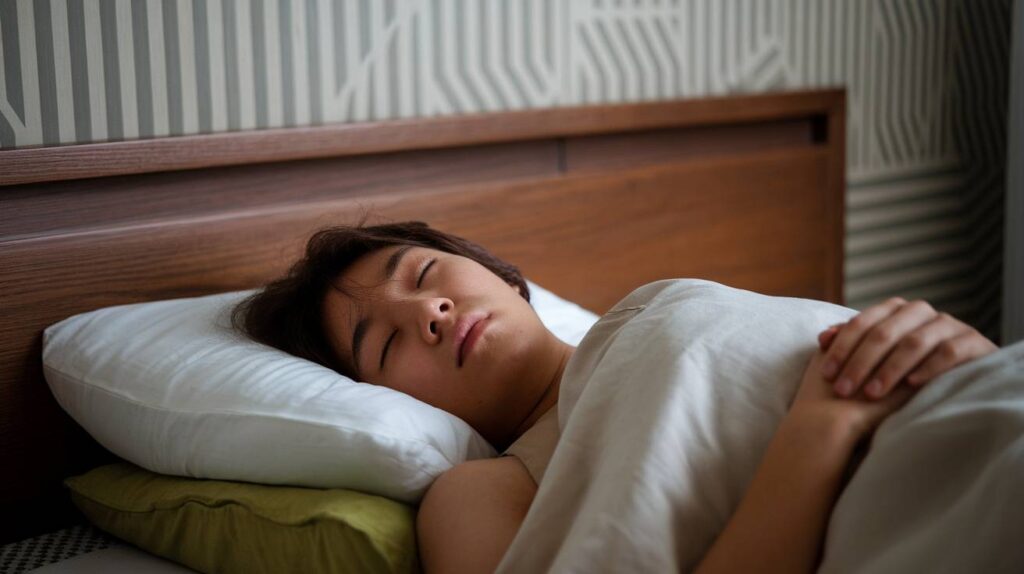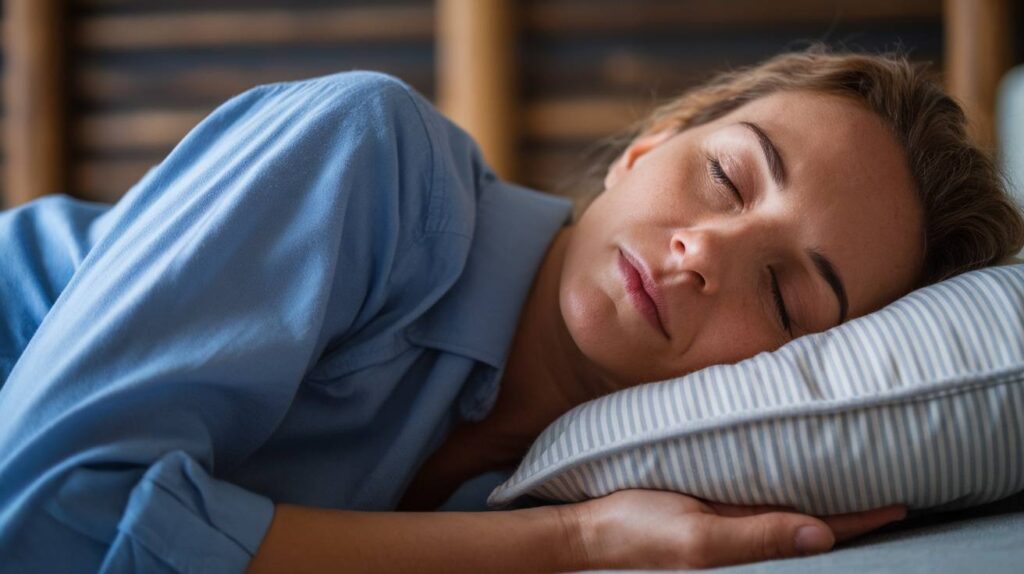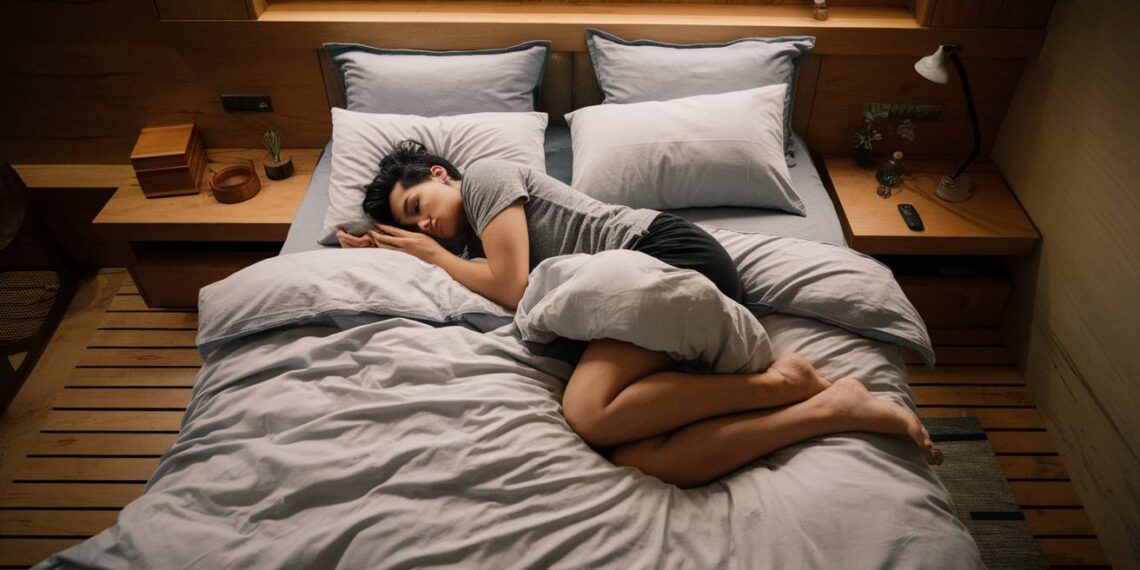Did you know that your sleep position can make or break your health? Whether you snooze on your back, curl up on your side, or sprawl on your stomach, the way you sleep impacts more than just comfort—it affects your spine, breathing, and even digestion. Mayo Clinic experts share their top tips for unlocking the secrets of the best sleep positions tailored to your health. From alleviating back pain to managing sleep apnea, this guide dives into the pros and cons of each position, empowering you to wake up refreshed, energized, and ready to take on the day.
Key Takeaways
- Best Sleep Positions: Mayo Clinic recommends side or back sleeping for overall health benefits.
- Health Impacts: Sleep positions influence back pain, sleep apnea, and acid reflux.
- Custom Adjustments: Using pillows for alignment enhances comfort and spinal support.
- Avoid Stomach Sleeping: It strains the neck and spine, potentially causing discomfort.
- Training Tips: Simple techniques can help transition to healthier sleep postures.
Discover the Best Sleep Position for Health: Insights from Mayo Clinic
Getting a good night’s sleep is essential for overall health and well-being. However, many people overlook the importance of their sleep position and how it affects their health. In this comprehensive guide, we’ll explore the best sleep positions according to Mayo Clinic experts, and how they can impact various health concerns such as back pain, sleep apnea, and more. Whether you’re a side sleeper, back sleeper, or stomach sleeper, understanding the pros and cons of different positions can help you improve your sleep quality and wake up feeling refreshed.

What is the ideal sleep position according to Mayo Clinic?
Mayo Clinic, a renowned leader in sleep medicine, suggests that the best sleep position varies depending on individual health needs. However, they generally recommend sleeping on your back or side as the most beneficial positions for overall health.
“The way you sleep determines how you feel when you wake up.” — Mayo Clinic
How does sleeping on your back benefit your health?
Sleeping on your back is often considered the best position for maintaining proper spine alignment. When you sleep on your back, your head, neck, and spine remain in a neutral position, which can help prevent unnecessary strain on these areas. This position may also reduce acid reflux, minimize wrinkles, and maintain perky breasts. However, it’s important to note that sleeping on your back may exacerbate snoring and sleep apnea in some individuals.
Why might side sleeping be recommended?
Side sleeping is another position that Mayo Clinic often recommends, particularly for those who experience back pain or sleep apnea. Sleeping on your left side can be especially beneficial as it may improve circulation and reduce heartburn. The fetal position, a variation of side sleeping where you curl your knees towards your chest, can be particularly comfortable for pregnant women and may help alleviate lower back pain.
Is sleeping on your stomach ever advisable?
While some people find stomach sleeping comfortable, Mayo Clinic generally advises against this position. Prone sleeping can strain your lower back and neck, as it’s difficult to maintain a neutral spine position. However, if you’re a dedicated stomach sleeper, placing a thin pillow under your pelvis can help reduce some of the strain on your back.
How does your sleep position affect back pain?
Your sleep position plays a crucial role in managing back pain. The right position can alleviate discomfort, while the wrong one may exacerbate existing issues or even create new problems.
“Small changes to your sleep posture can lead to big health benefits.” — National Sleep Foundation
Which positions can alleviate lower back pain?
For those suffering from lower back pain, side sleeping with a pillow between the knees can help maintain proper spine alignment. This position may reduce pressure on the lower back and provide relief. Alternatively, sleeping on your back with a pillow under your knees can also help maintain the natural curve of your spine and reduce strain on your lower back.
Are there sleep positions that may worsen back pain?
Sleeping on your stomach is generally considered the worst position for back pain. This position can flatten the natural curve of your spine and put unnecessary stress on your back muscles. If you must sleep on your stomach, try placing a thin pillow under your pelvis to reduce some of the strain.

How can you modify your sleep position to reduce back discomfort?
To modify your sleep position for better back health, consider using supportive pillows. If you’re a side sleeper, place a pillow between your knees to keep your hips aligned. Back sleepers can benefit from a pillow under their knees to maintain the natural curve of the spine. Remember, the goal is to keep your spine in a neutral position throughout the night.
| Position | Benefits | Drawbacks | Best For |
|---|---|---|---|
| Back Sleeping | Aligns spine, reduces reflux | May worsen sleep apnea, causes snoring | Acid reflux, spine support |
| Side Sleeping | Improves circulation, reduces apnea | Shoulder discomfort if overused | Sleep apnea, digestion |
| Stomach Sleeping | Comfort for some | Strains neck and spine | Rarely recommended |
What are the best sleep positions for improving sleep quality?
The best sleep position for improving sleep quality can vary from person to person, but certain positions are generally associated with better sleep outcomes.
How does the fetal position impact sleep quality?
The fetal position, where you sleep on your side with your knees drawn up towards your chest, is one of the most popular sleep positions. It can be particularly beneficial for pregnant women and may help reduce snoring. However, curling up too tightly in this position can restrict deep breathing, so it’s important to keep the posture relatively loose.
Can sleeping on your left side enhance overall sleep?
Sleeping on your left side is often recommended for better sleep quality. This position may improve circulation, reduce acid reflux, and even boost digestion. It’s particularly beneficial for pregnant women as it increases blood flow to the uterus. However, constantly sleeping on one side can potentially cause shoulder pain, so it’s good to alternate sides if possible.
What role does the prone position play in sleep quality?
The prone position, or sleeping on your stomach, is generally not recommended for optimal sleep quality. While some people find this position comfortable, it can lead to neck and back strain, potentially disrupting sleep. If you do sleep in this position, use a thin pillow or no pillow at all to minimize neck strain.
How can changing your sleep position help with sleep apnea?
Sleep apnea, particularly obstructive sleep apnea, can be significantly affected by sleep position. Changing your sleep position can be a simple yet effective way to manage this condition.
Why is side sleeping often recommended for sleep apnea sufferers?
Side sleeping is often recommended for people with sleep apnea because it helps keep the airway open. When you sleep on your side, gravity helps prevent the tongue and soft tissues in the throat from collapsing into the airway, which is a common cause of obstructive sleep apnea. Left-side sleeping, in particular, may be beneficial as it can reduce acid reflux, which can exacerbate sleep apnea symptoms.

How does sleeping on your back affect obstructive sleep apnea?
While sleeping on your back is generally good for spine alignment, it can worsen obstructive sleep apnea. In this position, gravity can cause the tongue and soft palate to fall back into the throat, potentially blocking the airway. If you prefer sleeping on your back but suffer from sleep apnea, elevating your head slightly with a wedge pillow may help keep your airway more open.
Are there specific pillow arrangements to combat sleep apnea?
Yes, specific pillow arrangements can help combat sleep apnea. For side sleepers, a thick pillow that keeps the head in line with the spine can help maintain an open airway. Back sleepers might benefit from a wedge pillow or an adjustable bed that allows for slight elevation of the upper body. Some people find relief using specially designed pillows that encourage side sleeping and proper head positioning.
What sleep positions does Mayo Clinic suggest for neck and shoulder pain?
Mayo Clinic recognizes that sleep position can significantly impact neck and shoulder pain. The right position can provide relief, while the wrong one can exacerbate discomfort.
How can you adjust your sleeping posture to relieve neck pain?
To relieve neck pain, Mayo Clinic suggests sleeping on your back or side with proper pillow support. When sleeping on your back, use a rounded pillow to support the natural curve of your neck, and a flatter pillow to cushion your head. Side sleepers should use a pillow that’s higher under the neck than the head to keep the spine aligned. Avoid sleeping on your stomach, as this position can strain your neck.
Which positions may exacerbate shoulder discomfort?
Sleeping on the affected shoulder can exacerbate shoulder discomfort. If you have shoulder pain, try sleeping on your back or on the opposite side. When side sleeping, hugging a pillow can help keep your top shoulder in a comfortable position and prevent it from rolling forward and straining.

Are there recommended pillow placements for neck and shoulder support?
For neck and shoulder support, pillow placement is crucial. Back sleepers should use a pillow that supports the natural curve of the neck without pushing the head forward. Side sleepers can benefit from a pillow between the knees to keep the spine aligned and a pillow in front of the chest to support the top arm, preventing it from pulling on the shoulder. Some people find relief using a body pillow, which can provide full-body support in a side-sleeping position.
How can you train yourself to sleep in a new position?
Changing your sleep position can be challenging, as our bodies often default to familiar positions during sleep. However, with persistence and the right techniques, it’s possible to train yourself to adopt a new, healthier sleep position.
What techniques can help you maintain a new sleep position throughout the night?
To maintain a new sleep position, start by consciously positioning yourself in the desired posture when you first go to bed. Use pillows to support your body and make the new position more comfortable. Some people find success in wearing a sleep shirt with a pocket and placing a tennis ball in it to discourage rolling onto their back or stomach. Alternatively, you can try using positional sleep aids designed to keep you in a specific position.
How long does it typically take to adapt to a new sleeping posture?
Adapting to a new sleep posture can take time, typically anywhere from a few weeks to a couple of months. It’s important to be patient and consistent. Your body needs time to adjust to the new position, and you may experience some discomfort initially. If discomfort persists after several weeks, consult with a healthcare provider to ensure the new position is appropriate for your needs.
Are there any tools or accessories that can assist in changing sleep positions?
Several tools and accessories can help you change and maintain a new sleep position. Body pillows can provide full-body support for side sleeping. Wedge pillows can help elevate the upper body for back sleepers with acid reflux or sleep apnea. Cervical pillows are designed to provide proper support for the neck. For those trying to avoid sleeping on their back, positional devices that strap around the waist can make side sleeping more comfortable. Memory foam mattresses can also help by conforming to your body in its new position, providing support and reducing pressure points.
In conclusion, finding the best sleep position for your health is a personal journey that may require some experimentation. By understanding the recommendations from Mayo Clinic and considering your individual health needs, you can work towards achieving better sleep quality and overall well-being. Remember, if you continue to have problems sleeping or experience persistent pain, it’s important to consult with a healthcare professional or a sleep medicine specialist. With the right approach, you can improve your sleep posture and wake up feeling refreshed and ready to face the day.
Conclusion
Your sleep position is more than just a personal preference—it’s a cornerstone of good health. Mayo Clinic’s insights reveal that back and side sleeping are optimal for aligning your spine, reducing back pain, and improving conditions like sleep apnea or acid reflux. Small adjustments, such as using supportive pillows or alternating sides, can make a significant difference. While stomach sleeping poses challenges, even this can be modified with minor tweaks. By understanding and experimenting with these positions, you can optimize your sleep quality and wake up feeling refreshed and pain-free. Don’t just sleep—sleep smart.
FAQ
What is the best sleep position according to Mayo Clinic?
According to Mayo Clinic, sleeping on your side is generally considered the best position for overall health. This position can help reduce snoring, alleviate acid reflux, and may be beneficial for people with low back pain. However, the best way to sleep can vary depending on individual health conditions.
Is sleeping on the back recommended?
Sleeping on the back, also known as the supine position, can be beneficial for some people. It helps maintain spine alignment and may reduce neck or back pain. However, this position can exacerbate snoring and is not recommended for those with obstructive sleep apnoea. The Mayo Clinic suggests that if you sleep on their back, placing a small pillow under the knees can help maintain the spine’s natural curve.
What are the drawbacks of sleeping on the stomach?
Sleeping on the stomach is generally considered the least favorable position by sleep experts, including those at Mayo Clinic. This position can strain your lower back and neck, potentially leading to pain and discomfort. It may also interfere with proper breathing. If you must sleep this way, use a thin pillow or none at all to minimize neck strain.
How does sleep position affect your health?
Your sleep position affects your health in various ways. It can influence breathing patterns, spinal alignment, and even digestion. The right position can help you sleep well, reduce pain, and improve overall health. According to studies on the influence of spontaneous sleep positions on nighttime recumbent reflux, certain positions may also affect conditions like acid reflux.
Is sleeping on the right side better than the left?
While both sides offer benefits, sleeping on the left side is often recommended. It can help reduce acid reflux and may improve circulation. However, sleeping on the right side might be more comfortable for some people. The Mayo Clinic suggests alternating sides if you’re a dedicated side sleeper to prevent issues like shoulder pain.
What is the most common sleep position?
According to the Sleep Foundation, the most common position people sleep in is on their side. This is followed by sleeping on the back and then on the stomach. However, many people change positions throughout the night, which is normal and can help prevent discomfort from staying in one position too long.
How can I adjust my sleep position for better health?
To adjust your sleep position for better health, start by trying to sleep on your side or back if you’re currently a stomach sleeper. Use pillows to support your body and maintain proper alignment. If you have specific health concerns, consult with your healthcare provider about the best position for your needs. Remember, the best position is ultimately the one that allows you to sleep well and wake up without pain or discomfort.
Resources
Final Thoughts
Improving your sleep position is a simple yet impactful way to boost your overall health. From reducing pain to enhancing breathing, the right posture can transform your nights and your mornings. Take the time to assess your habits, experiment with adjustments, and use tools like supportive pillows for alignment. If persistent discomfort arises, don’t hesitate to consult with a healthcare provider. The road to better sleep starts with one conscious choice—why not make it tonight?
Recommended Products
- Memory Foam Pillow: Supports neck alignment
- Wedge Pillow for Back Sleepers: Reduces acid reflux
- Body Pillow for Side Sleepers: Enhances comfort
- Adjustable Bed Frame: Elevates upper body for sleep apnea
- Cooling Mattress Protector: For a restful night








